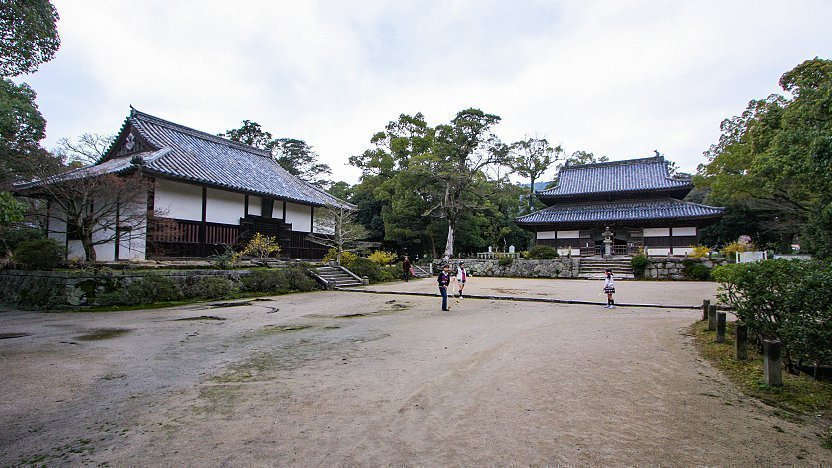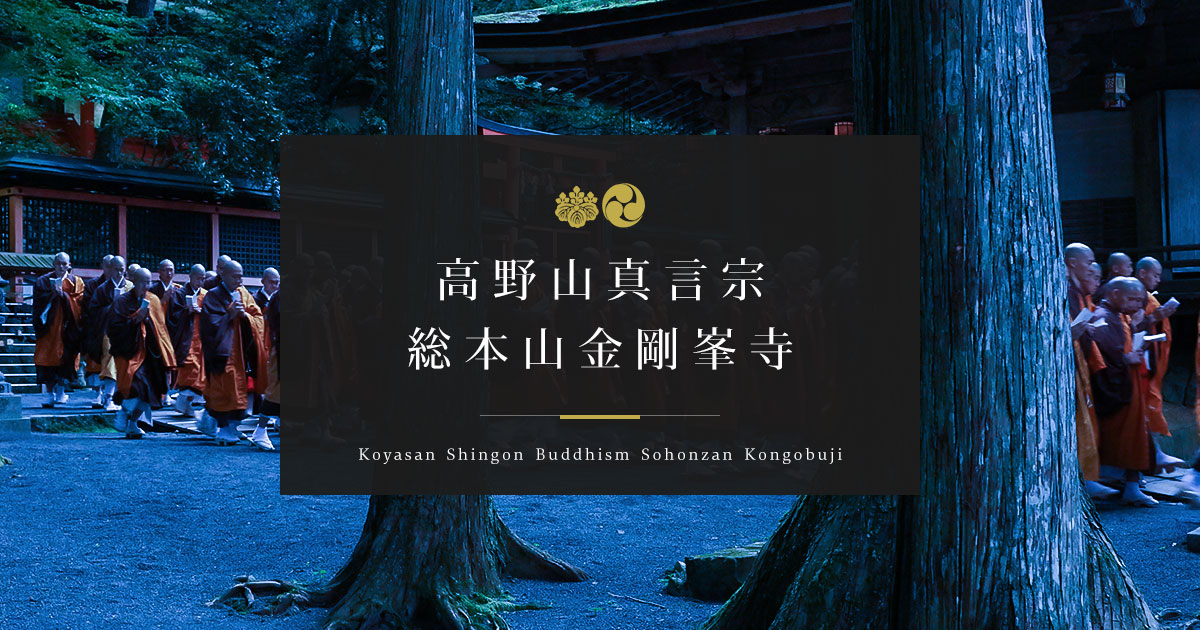Introduction
“空海 (Kukai)” is the founder of the “真言宗 (Shingon sect of Buddhism)”, who brought esoteric Buddhism to Japan. He was one of “三筆 (Sanpitsu)”, the first group of three famous ancient calligraphers. This article describes Kukai’s contributions to calligraphy.
Life of Kukai
Birth of Kukai
Kukai was born at an temple, Zentsujii, in Kagawa, Japan on June 15, 774. His childhood name was “真魚 (Mao)”. He was intelligent from an early age. He learned poetry, Chinese language, and Confucianism from his uncle, who was an educator for the prince of “桓武天皇 (Emperor Kanmu)”. At the age of 15, his uncle encouraged him to go to the capital, Kyoto, and devote himself to study. When he was 18 years old, Kukai entered a university. However, the university is for training bureaucrats, which was not what Kukai wanted to learn. He desired to help people in need. Believing that Buddhism was important for this purpose, Kukai decided to drop out of the university and pursue the path of a Buddhist monk.


After dropping out of university, Kukai undertook mountain ascetic practices in Shikoku and Wakayama, Japan, and studied Buddhism at a temple, 久米寺 (Kumeji) in Nara. He studied in Nara, Tokushima, and Shikoku, and at the age of 20, he received the precepts to become a monk. At the age of 22, he changed his name to “空海 (Kukai)”. “空 (Ku)” means the sky, and “海 (Kai)” means sea. It is said that he was struck by the sky and sea, when he emerged from this cave after his ascetic practices and took the name “空海 (Kukai)”. This is the origin story of his name. The cave where he undertook the ascetic practice at the time is called Mikurodo in Cape Muroto, Kochi.
*Shikoku is an area of Japan which consist of Kagawa, Tokushima, Kochi, and Ehime.
The cave, Mikurodo in Cape Muroto, is a part of “The Shikoku Pilgrimag”. Check 88 Buddhist temples of “The Shikoku Pilgrimag”!

Kukai’s Journey to Tang China
Kukai continued his Buddhism training and encountered “大日経 (Dainichi-kyo)”, an esoteric Buddhism scripture, at Kume-dera Temple in Nara, Japan. He believed that the teachings of esoteric Buddhism could not be understood only by reading the scriptures, so he sought an opportunity to travel to Tang which is the major country in China in the era.
At the age of 30, he went to Tang as one of the envoys to the Tang Dynasty by order of Emperor Kanmu. In 804, he left for Tang from Taura in Nagasaki, Japan by the same ship with “最澄 (Saicho)”, who later founded the Tendai sect of Buddhismin Japan, and “橘逸勢 (Tachibana Hayanari)”, who is one of three famous ancient calligraphers.
Upon arriving in Tang, he studied esoteric Buddhism very hard, with learning Sanskrit language necessary to understand esoteric Buddhism. About 6 months later, he went to see”恵果 (Eka/Keika)”, a Tang’s national teacher and a monk who officially inherited esoteric Buddhism of Shingon sect. He admitted Kukai at first sight and made Kukai his disciple, imparting all of esoteric Buddhism to him. The imparting included the secret method of mandala. Keika admitted Kukai as a “master of Shingon esoteric Buddhism only in 3 months, very short duration.
青龍寺/青龙寺 (Qinglong Temple) is the Buddism temple where Kukai studied. It is located Xian, China. Let’s visit the temple in the historical city!

Return to Japan and Establishment of Shingon Sect
In 806, about two years after his arrival in Tang, Kukai returned to Japan. He brought back to Japan from the Tang Dynasty a vast amount of Buddhist artifacts, Buddhist scriptures, and calligraphy of the Jinshin period in which “王羲之 (Oh gishi/Wang Xizhi) was active. After returning to Japan, Kukai stayed at Kanzeonji Temple in Dazaifu for about 2 years. In 809, he entered Takaosanji Temple in Kyoto, now known as Jingoji Temple.

Kukai brought back to Japan both parts of esoteric Buddhism, consisting of the “Mahavairocana Sutra (大日経 だいにちきょう)” and “Vajrayana Sutra (金剛頂経 こんごうちょうきょう),” but struggled to propagate it because of the obstacles posed by the high priests of the Southern Buddhism, called as old factions. Saicho, who brought partial esoteric Buddhism back to Japan earlier, similarly struggled to propagate it. Since Saicho had brought back only partial esoteric Buddhism, he wrote letters to Kukai asking to borrow sutras. Kukai wrote a reply to the letters, which is known today as the “風信帖 (Fushinjo)”.
In 806 or 810, he found Shingon sect. In 810, he was officially authorized by Emperor Saga to propagate esoteric Shingon Buddhism. In 816, he received permission from “嵯峨天皇 (Emperor Saga)” to establish Kongobuji Temple on Mt. Koya. In 828, Kukai founded the first private school in Japan, “綜芸種智院 (Shugei Shuchi-in)” in Kyoto. The school was an educational institution for common people in the early Heian period (794-1185). Universities and national colleges had strict status restrictions as the addmittion policies, so it was difficult to access to higher education for the general public in that era. However, Kukai provided opportunity to get education for the commoners by establishing “綜芸種智院 (Shugei Shuchi-in)”.

In 835, Kukai passed away when he was 62 years old. In 918, 83 years after his passing away, “醍醐天皇(Emperor Daigo)” sent him the posthumous title of “弘法大師 (Koho-Daishi)”.
Kukai’s Contributions to Calligraphy
Kukai learned the techniques of making brush and paper in Tang. He taught that a calligrapher must always use a good brush, and that the brush must be changed according to the different characters and different calligraphic styles. There is a proverb, “a good calligrapher never chooses his brushes,” but Kukai select brushes seriously in actual.
During Kukai’s stay in the Tang Dynasty, a new style of calligraphy had been established by Yan Zhenqing, in contrast to the previously prevailing style of Wang Xizhi, and this new style of calligraphy was in vogue. Kukai studied the new style.
Kukai was also a scholar of calligraphy, and a book, “性霊集 (Seiryo-shu)” written by him contains a great deal of useful information on calligraphy. He also created the oldest existing dictionary about Kanji in Japan, called “篆隷万象名義 (Tenrei-bansho-meigi)”.
“篆隷万象名義 (Tenrei-bansho-meigi)” is a National Treasure in Kosanji, a temple in Kyoto, Japan. Let’s go to see teasures in Kosanji!
Kukai’s Calligraphic Style
Influenced by the calligraphic styles of “王羲之 (Oh gishi/Wang Xizhi)” and “顔真卿 (Yan Zhenqing)“, Kukai could have written not only in ”楷書 (Square Style)”, “行書 (Running Style)”, and “草書 (Cursive Style)” skillfully, but also in ”seal‐engraving style”, “隷書 (Clerical Style)”.
At the time of Kukai’s arrival in Tang, a new style of calligraphy was gaining popularity in Tang, centering on the calligraphy of a great master, Yan Zhenqing. Kukai also learned the new style and he was inspired by the works of Yan Zhenqing and other Tang calligraphy style. Kanjo-rekimei are similar to Saitetsu-bunko written by Yan Zhenqing.
On the other hand, Kukai also studied the calligraphy of Wang Xizhi, and his style was familiar with various styles and expressions of the Tang dynasty, including that of Yan Zhenqing, but it is thought that Wang Xizhi’s calligraphy was the premise for his study. His masterpiece “Fushinjo” (風信帖) also has Wang Xizhi’s calligraphy as its foundation.
Kukai’s works
Fushinjo (風信帖), Koppijo (忽披帖), Kokkeijo (忽恵帖)
A masterpiece of Kukai’s calligraphy. This letter is addressed to Saicho (最澄), who traveled to Tang China in the same ship with Kukai. Originally, five letters are said to have existed, but only three letters, “Fushinjo (風信帖)”, “Koppijo (忽披帖)”, and “Kokkeijo (忽恵帖)”, have survived. One was stolen, and the another is said to have fallen into the hands of Hidetsugu Toyotomi (豊臣秀次), a leader of Samurai.
The name of each letter is derived from the first two characters. For example, it is called “Fushinjo (風信帖)” because it begins with the two characters “風信 (Fushin)”. The three letters, “Fushinjo (風信帖)”, “Koppijo (忽披帖)”, and “Kokkeijo (忽恵帖)”, are sometimes referred to collectively as “Fushinjo (風信帖)”. These letters are not usually open to the public, as “Fushinjo (風信帖)” is located at To-ji (東寺) Temple in Kyoto.
Fushinjo (風信帖)
Saicho sent a sutra, “Maka-Shikan (摩訶止観)”, to Kukai to let him know the basics of the Tendai sect he founded. In the “Fushinjo,” he wrote a thank-you letter to Kukai.

Koppijo (忽披帖)
In “Koppijo (忽披帖)”, Saicho expresses his gratitude to Saicho for sending him the incense and a letter of Fujiwara Fuyutsugu (藤原冬嗣). Kukai apologizes in “Koppijo (忽披帖)”, for not being able to visit Enryakuji Temple (延暦寺) on Mount Hiei (比叡山), where Saicho founded the Tendai sect of Buddhism, because Kukai did not have time to visit the temple.

Kokkeijo (忽恵帖)
Again, Saicho urged him to visit Enryakuji Temple on Mt. Hiei, but Kukai replied in Kokkeijo (忽恵帖) that he wanted Saicho to wait until September 10, citing his disciples and his own practice. While Saicho wanted to quickly obtain the latest information on esoteric Buddhism, Kukai emphasized the practice of physical training and avoided practices that relied solely on books and sutras.

Kanjo-rekimei (灌頂歴名)
The style of calligraphy is the most similar with “Fushinjo”. It is a personal biographical record of a person who received Kanjo, a consecration ceremony by pouring water onto the top of monk’s head.
This work is deposited in the Kyoto National Museum, Japan. The work will be on display at Jingo-ji Temple from May 1 to 5 each year, when the insect-drying ceremony is held at the temple. The work is sometimes exhibited in special exhibitions held at other museums.

Sanjujo-Sakushi (三十帖策士)
A calligraphy work written during the Tang, in Square Style and Cursive Style. A buddism copied book by Kukai, a secret book of the Shingon sects.
This work exist in Ninnaji temple, Kyoto, Japan.

The Other Works
- “座右銘 (Zayu-no-mei)”
- “金剛般若経開題 (Kongo-hannyakyo-kaidai)”
- “大日経疏要文記(Dainichikyo-soyo-monki)”
Conclusion
Kukai’s calligraphic works and Buddhism thought are still loved by many people, today. His contributions to calligraphy and Buddhism are indispensable to the history of Japanese calligraphy and Buddhism.


Comments